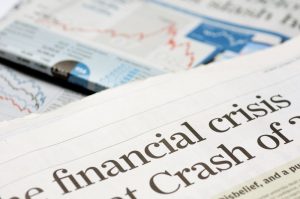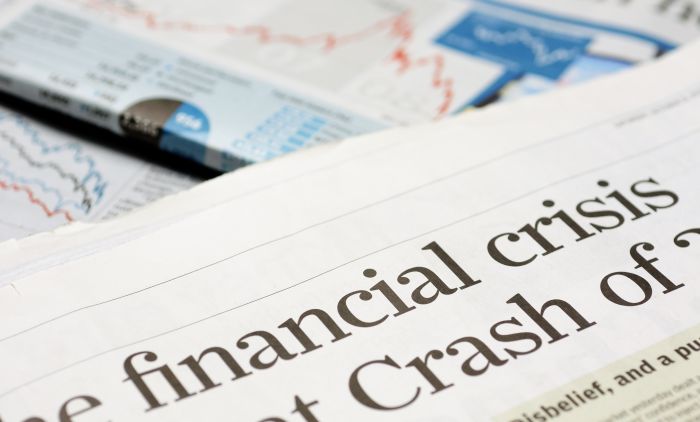Experts from academia and industry gathered at the University of Oxford to revisit what went wrong in the run-up to the 2008 financial crisis, whether the actions that were taken since seem sufficient, and the risks that might forestall a new crisis.

The bankruptcy of Lehman Brothers, now ten years ago, was neither the start nor the peak of the financial crisis. Yet, the demise of the iconic investment bank, the fourth-largest in the United States, marked the point at which the unthinkable became real: A landmark institution, loaded with low-quality securities and protected by little capital, teetered—and the government allowed it to fail. As confidence dissipated and uncertainty grew, a total collapse of the financial system seemed not only possible but also plausible.
Ten years later, experts from academia and industry gathered at the University of Oxford to reflect on what happened. As part of a conference on the political economy of finance for early career researchers, the panel was asked to revisit what went wrong, whether the actions that were taken to prevent a repeat of the crisis seem sufficient, and what risks could forestall a new crisis. Sir John Vickers, Warden of All Souls College at Oxford University, former member of the Bank of England’s Monetary Policy Committee and chair of the UK’s Independent Commission on Banking, captured the mood well when he noted: “We are safer, but not as safe as we should and could be.”
What Went Wrong?
Vickers noted that the set of economic circumstances that preceded the crisis, although extraordinary, are too often given too much credit for what followed. “It was not a perfect storm. The biggest surprise of the crisis was not the shock, but the fragility it exposed.” Emblematic for that fragility was the leverage in the financial system, which Vickers described as “extreme.” And that is only what we know. Karthik Ramanna, Professor of Business and Public Policy at Oxford’s Blavatnik School of Government, noted that the accounting underlying the capital requirements and the reporting of leverage ratios obscured much leverage: “The tier-one capital [the highest-quality assets that regulators require banks to hold] are full of potentially non-performing assets.” Furthermore, the capital was supposed to be held against the risks generated by the products the banks held or were exposed to. But many of these products, Ramanna noted, were novel, complex, and ill-understood. The fragility we observed by looking at leverage ratios, in other words, was only the tip of the iceberg.
Grace Blakeley, a research Fellow at the IPPR Commission on Economic Justice, argued that fragility was not only endemic in the financial sector but characterized the broader economic model it was a part of. “For decades, returns in the real economy were low, which created global imbalances and a hole in aggregate demand. Financialization helped fill that hole, in ways that we now know may have been artificial and unsustainable.”
Have We Fixed the Financial System?

Following the crisis, there was little debate about the need for reform of the financial system. Instead, much of the debate centered on the question of the design of these reforms. Ten years on, banks have to hold more capital, are subjected to liquidity requirements, face more stringent governance and compliance expectations, and have had to submit resolution plans to aid resolvability in times of crisis.
Despite that progress, Vickers is not satisfied. “The discussion on capital has got to a really weird place. You have the officialdom, with the Governor of the Bank of England [Mark Carney] as a leading exponent, holding the view the system is now sufficiently capitalized. At the same time, others—most economists outside the official sector—stress that leverage can still be thirty [debt of thirty times equity], and instead want to see that multiple much lower, say at ten or even three. I would put my own view between these two; regulators should have increased capital buffers much more than they have.” Emily Jones, Associate Professor at Oxford’s Blavatnik School of Government and chair of the panel, asked why more ambitious regulation of leverage ratios had not been introduced. Vickers suggested that while it may be because “officialdom is right,” it likely was also driven by the process of reaching international agreements, “which tend to reach the lowest common denominator.”
Giles Keating, managing director at Werthstein and a former Global Chief Economist at Credit Suisse, also sounded a cautionary note. He noted that “an awful lot of progress has been made,” citing in particular the increased capital requirements, but stressed that focusing just on regulatory change in banking regulation obscures instabilities elsewhere in the system. “The financial system is an ecosystem; all parts are closely related. Changes in one area can have effects on different players in different ways. Perhaps, the financial system is more complicated than a natural ecosystem, because there is this layer of players gaming the system superimposed on it.” Even if raising capital requirements for banks was the right idea, doing so without evaluating and mitigating the spillovers that might affect other parts of the financial ecosystem—particularly related to financial activity moving into the more lightly regulated shadow banking sector—is not necessarily a prudent move. Borrowing may have moved outside banks, but that does not necessarily make the financial industry less fragile.
On the question of whether the system is now safer, Blakeley countered with “safer for whom?” She stressed that while regulatory interventions in the aftermath of the crisis no doubt made the financial system more stable, they coexisted in the UK with policies that have done little to address inequality or economic stability for the most vulnerable. She urged that legacies of the financial crisis be seen holistically, rather than analyzing monetary and regulatory interventions separately from fiscal policy, and instead advocated for more comprehensive and robust public interventions to address stagnating wages and faltering productivity growth.
Risks On the Horizon: The Old and the New
Keating expressed concerns that, particularly in the realm of monetary policy, there are spillovers that could plant the seeds of a future crisis. He explained that he holds a “darker” view of the “knock-on effects of regulatory changes.” “As we escaped from the global financial crisis, quantitative easing and ultra-low interest rates were important,” he said. “But this has gone on for too long.” As a consequence, Keating argued, we now witness the emergence of asset bubbles in the bond market and debt levels that are even higher than before the crisis (resulting in dangerously high leverage in the US corporate sector). Keating argued that this has been made worse by a lack of coordination by monetary policymakers, citing the example of how Japan’s low target for ten-year government bond yields might have encouraged people to move their capital abroad. “This is yet another example of unintended policy spillovers.”
“We have to wonder how this will end,” Keating concluded. “This year’s crises in emerging markets are merely a foretaste. As inflation comes back into the system, which is inevitable now that central banks (led by the US Federal Reserve) have to begin to raise rates, the weakest parts of the system are squeezed first, as is always the case at the end of a credit cycle.” This will affect emerging markets, but also corporate debt—particularly but not exclusively in the United States. The fact that market-making, as a consequence of regulatory reform, is not as easy as it once was only makes matters worse. “The good news, however, is that the banking system is safer. This matters a lot, as this is the store of value for many people and the way that many financial transactions are processed.” But banks, he cautioned, will not be exempt from the nasty credit cycle entirely.
Apart from capital standards being too low, the unresolved challenges relating to accounting standards in capital regulation remain a source for concern, Ramanna noted: “Major banks in Europe have very low price-to-book ratios—essentially the market’s assessment over the accountant’s assessment. If the market is right, there is a very substantial over-measuring of capital in the bank.” The regulation, and the stress tests used by central banks to evaluate the bank’s resilience, rely on the accounting measure. Ramanna: “These tools are only as good as [the accounting numbers] that go in there.” Vickers suggested that banks with low price-to-book ratios should be subjected to additional stress tests that are based on market measures of capital.
Keating was supportive of the idea, noting that it would help regulators to use the information produced by markets and also help overcome some of the informational asymmetries governments suffer from when regulating financial institutions. At the same time, he was skeptical that the proposal would be implemented. “Looking at the price-to-book ratios of banks, you can very clearly see the variation across countries and regions. US banks are performing relatively well, but the same cannot be said about their European counterparts.”
Blakeley claimed that expertise is (still) divided unequally between the private sector and the government, which makes it harder for government to effectively regulate the financial system. Explaining how patterns of regulatory influence can be skewed, she said: “This is a matter of money and power…. It erodes the trust in government.”
Finally, drawing attention to the larger economic context, Ramanna stressed future political challenges arising from computerization and the changing structure of work in advanced economies. Noting that most advanced economies, especially the UK, experienced stagnating productivity growth, he argued that future economic growth was likely to come from technology and computerization. This will result in a massive transformation of the labor market—recent research by Carl Frey and Michael Osborne at the Oxford Martin School has suggested up 47 percent of jobs are vulnerable to computerization. Managing such a disruptive change in the economy equitably and fairly will be a major political challenge going forward.
A Call to Action
In the end, the key to preventing crises is to be aware of the developments around you and critically evaluate them. Vickers spoke frankly: “Many who should have known what was going on—also in academia—were totally unaware. For example on the ballooning of leverage, I should have known, but I did not.” He concluded that engagement is key, too: “When the Bank of England consulted on extra capital buffers for big banks, it received just four responses, and one was mine.”
The academic community can be occasionally slow in engaging with policy makers and challenging the dominant paradigms. Early-career scholars’ remarkable interest in asking difficult questions on political economy of finance, however, suggests there is room for optimism.
The research portion of the conference included presentations from emerging scholars on complex challenges in the political economy of finance, often with deep distributional repercussions. There were three key lessons learnt from junior scholars’ presentations. First, there is a great value in moving beyond disciplinary boundaries to ask important questions. In just two days, presenters showcased the breadth of the emerging scholarship in political economy of finance, ranging from a historical perspective on early 20th century Swiss capital requirements to the recent reforms in Turkey, China, and the United States. At the international level, scholars asked why countries rely on domestic insurance mechanisms (rather than the global financial safety net) and how principles of bankruptcy law can be applied to sovereign debt.
Second, conversations among scholars from different disciplinary backgrounds are essential for gaining a thorough understanding of how markets operate, and the extent to which better cooperation between multiple stakeholders can support sustainable capitalism. Third, to address the most pressing challenges of today’s globalized economy, it is vital for the academic community to engage with practitioners to have a clear voice in the policy arena.
Jure Jeric, Thom Wetzer and Alexandra Zeitz are DPhil (PhD) candidates at the University of Oxford.
For more on this, listen to the Capitalisn’t podcast’s 3-part series on the 2008 financial crisis:
Disclaimer: The ProMarket blog is dedicated to discussing how competition tends to be subverted by special interests. The posts represent the opinions of their writers, not necessarily those of the University of Chicago, the Booth School of Business, or its faculty. For more information, please visit ProMarket Blog Policy.






